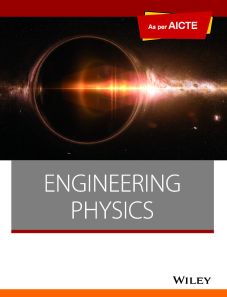Engineering Physics, As per AICTE
ISBN: 9788126521418
804 pages
Publication Year: 2020
For more information write to us at: acadmktg@wiley.com

Description
The Engineering Physics course is designed with an objective to build a solid foundation in fundamentals
of physics and relate these to engineering applications. This book offers complete coverage of the course as per the latest AICTE recommended curriculum. Starting with Introduction to Electromagnetic Theory, the book covers concepts in Mechanics and Quantum Mechanics important from engineering
perspective and then topics in Oscillations, Waves and Optics.
1. Electrostatics
1.1 Introduction
1.2 Electric Field and Electrostatic Potential for a Charge Distribution
1.3 Divergence and Curl of Electrostatic Field
1.4 Laplace’s and Poisson’s Equation for Electrostatic Potential (General Theory)
1.5 Electrostatics in Practical Applications
1.6 Boundary Conditions of Electric Field and Electrostatic Potential
1.7 Method of Images
1.8 Energy of a Charge Distribution and Its Expression in Terms of Electric Field
2 Electrostatics in Linear Dielectric Medium
2.1 Introduction
2.2 Electrostatic Field and Electrostatic Potential of a Dipole
2.3 Bound Charges due to Electric Polarization
2.4 Electric Displacement
2.5 Boundary Conditions on Displacement
2.6 Solving Simple Electrostatics Problems (in Presence of Dielectrics)
3 Fundamentals of Magnetostatics
3.1 Introduction
3.2 Current and Current Density
3.3 Biot–Savart Law: Magnetic Induction of a Steady Current
3.4 Divergence and Curl of a Magnetic Field
3.5 Maxwell’s Equations
3.6 Magnetic Potentials
4 Magnetostatics in Linear Magnetic Medium
4.1 Introduction
4.2 Magnetization and Bound Currents
4.3 Auxiliary Magnetic Field H Vector (×

